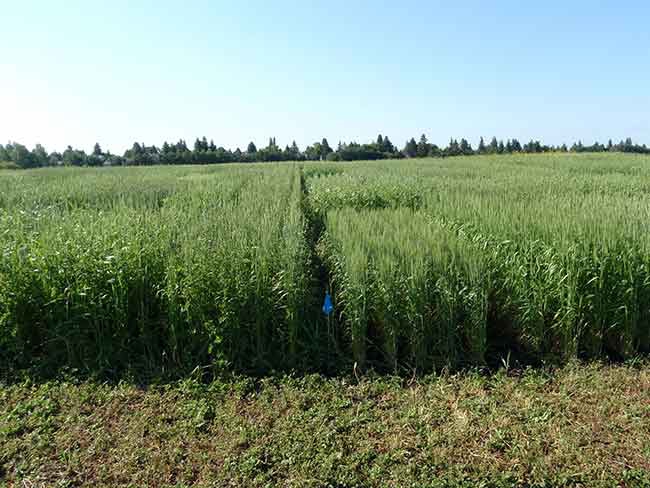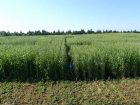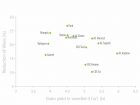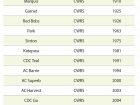
Features
Agronomy
Soil
Effect of weeds on soil AMF and agronomic traits in organic wheat
Arbuscular mycorrhizal fungi (AMF) are among the most common and ubiquitous soil microorganisms in almost all soil systems. They contribute to nitrogen and phosphorus absorption and translocation, alleviation of water stress, resistance to soil-borne pathogens and improvement of soil structure. Several studies have reported organic farming systems tend to have more diverse AMF communities.
November 8, 2016 By Hiroshi Kubota Sylvie A. Quideau Pierre J. Hucl and Dean M. Spaner*
 The weedy plots (left) had a higher percentage of AMF than the weeded plots (right). Arbuscular mycorrhizal fungi (AMF) are among the most common and ubiquitous soil microorganisms in almost all soil systems.
The weedy plots (left) had a higher percentage of AMF than the weeded plots (right). Arbuscular mycorrhizal fungi (AMF) are among the most common and ubiquitous soil microorganisms in almost all soil systems.This study was designed to increase knowledge of wheat-weed-AMF community interactions. The specific objectives were to examine potential differences in soil microbial communities between weeded and weedy environments in organic wheat fields, and to examine the weed competitive ability of 13 Canadian spring wheat cultivars grown in the organic hand-weeded and weedy environments.
Thirteen Canadian spring wheat cultivars were grown in organically managed, hand-weeded and weedy treatments in 2010 and 2011 at the University of Alberta research centre. The plots were seeded with a self-propelled, no-till double-disk plot drill. Thirteen Western Canadian spring wheat cultivars were chosen to differ by registration year and weed competitive ability. Weeded plots were maintained by daily hand-weeding throughout the wheat growing seasons to avoid soil surface disruption, while no-weeding was applied in the weedy treatment. Soil microbial community structure was characterized using phospholipid fatty acid (PLFA) analysis.
In 2010, grain yield averaged 76 bushels per acre (bu/ac) (5.12 tonnes per hectare, or t/ha) in the weeded treatment and 64 bu/ac (4.29 t/ha) in the weedy treatment. In 2011, grain yield averaged 67 bu/ac (4.53 t/ha) in the weeded treatment and 53 bu/ac (3.58 t/ha) in the weedy treatment. The weeded treatment exhibited greater grain yield and more tillers. Kernel weight, test weight, days to maturity, plant height, grain phosphorus (P) and protein content were not altered by weed treatment.
The cultivars CDC Go and CDC Kernen were relatively higher yielding in both weedy and weeded treatments (9.1 and 8.4 per cent reduction, respectively, compared with the average reduction of 17.8 per cent). High yield CWRS cultivars AC Superb, AC Barrie, CDC Go and CDC Kernen exhibited two different competitive strategies under weed stress. CDC Go and CDC Kernen maintained grain yield through minimizing tiller reduction caused by weed pressure. AC Superb and AC Barrie increased kernel weight, which minimized yield reduction. CDC Go and CDC Kernen were the most yield-stable cultivars in organic systems.
There was greater weed biomass in the weedy treatment. The average dry weed biomass at harvest was 2.15 and 1.87 t/ha for the weedy treatment in 2010 and 2011, respectively. The weeded treatment had an average dry weed biomass less than 0.03 t/ha in both years. We observed five main weed species in our weedy plots: Canada thistle, shepherd’s-purse, wild buckwheat, lamb’s-quarters, and field pennycress (stinkweed); and three weed species in the weeded plots: shepherd’s-purse, wild buckwheat and field pennycress.
Using combined data from 2010 and 2011, the per cent contribution of AMF to total PLFA was greater in the weedy than in the weeded treatment. Other soil microbial groups, species richness, diversity index and evenness were not altered in the weedy treatment and the weeded treatments. This result reinforces the notion that weeds are important for AMF development. The interaction between AMF communities and the density and species makeup of the weed population remains unclear. Further investigation is required to assess the function of mycorrhizal and non-mycorrhizal weed species in AMF proliferation.
*Editor’s note: This article is based on the Canadian Journal of Plant Science’s “Best Agronomy Article” for 2015. The journal article is open source to the public and can be downloaded in its entirety at www.nrcresearchpress.com/doi/abs/10.4141/cjps-2014-284.
Reference: Kubota et al. The effect of weeds on soil Arbuscular mycorrhizal fungi and agronomic traits in spring wheat (Triticum aestivum L.) under organic management in Canada. Can. J. Plant Sci. (2015) 95: 615-627.


